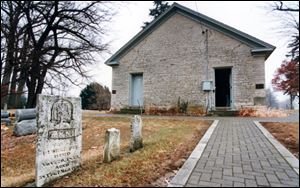
Ohio church was first Methodist mission
8/1/2009
The Wyandot Mission Church in Upper Sandusky was built by the federal government in 1824 for $1,333 at the request of the Wyandot tribe.
UPPER SANDUSKY, Ohio - When John Stewart felt the call of God to become a preacher in 1816, he traveled through the Ohio wilderness until reaching a Native American settlement here, 75 miles southeast of Toledo.
Frail of health and recovering from alcoholism, Stewart delivered his first sermon under a tree to an audience of one Wyandot Indian.
While other Christian missionaries had come to the area before him and failed to reach the fierce and independent tribe, Stewart persisted and his preaching - aided by his sonorous tenor voice - eventually led many Wyandots to convert to Christianity.
"He felt God wanted him to preach to the Indians and he went to the Indian agent, William Walker, who assigned Jonathan Pointer as his interpreter," said Jean Moon, a local historian who serves on a 12-member committee that oversees the church.
"The Indians had viewed the Bible as 'the white man's book,' but Stewart told them that God is the God of all people," Ms. Moon said. "And he had a lovely tenor voice. The Wyandots liked the music."
According to Moccasin Trails to the Cross, a 1974 history of the Wyandot Indian Mission written by the late Thelma Marsh, an Upper Sandusky historian, Stewart was regarded by the tribe as "an honest, sober, and humble servant of a personal God."
He died in 1823 at age 37, and a year later, at the request of the Wyandots, the federal government built the tribe a one-room church, made of Sandusky River limestone with a slate roof, at a cost of $1,333.
The Wyandot Mission Church, located on East Church Street in the Old Mission Cemetery, is the first officially recognized mission of the Methodist Episcopal Church in America.
Restored in 1889 and designated a National Shrine of the Methodist Church in 1960, the church is open during the summer months for nondenominational worship services every Sunday at 8 a.m. A Presbyterian service is held at 9:30 a.m. Sundays during August.
The historic church is also open for tours from 1 to 4 p.m. Friday through Sunday during June, July, and August, and can be viewed at other times by arrangement with John Stewart United Methodist Church, which oversees the mission.
John Stewart was born in Virginia in 1786 , the son of "free black" Baptists, according to local historians. His father came from an island near New Guinea or Indonesia and married an African woman before the couple immigrated to the United States, arriving at Newport News, Va.
When his family moved to Tennessee in 1816, Stewart was too ill to travel and stayed behind in Virginia, in an area that is now part of West Virginia.
In 1816, he traveled to Ohio and was robbed in Marietta. Destitute, despondent, and drunk on rum, he considered suicide, according to historians.
But Stewart found new life at a Methodist camp meeting, where he heard "a voice from heaven telling him to Go, declare my counsel faithfully."
He came to Upper Sandusky and began preaching to the Wyandots.
Some of the chiefs of the 12 Wyandot clans converted, which opened the door for Stewart to reach more of the tribe members.
Among the Wyandot chiefs who converted were warriors with colorful names such as Chief Between-the-Logs, Chief Tarhe, Chief Mononcue, and Chief Squire Grey Eyes."
The federal government had been trying to get the Wyandots to move west and resettle on reservations, but the tribe resisted until several of their members were attacked and killed by angry whites in 1842, according to Ms. Moon.
About 600 Wyandots then left Upper Sandusky for Kansas in 1843, and some of them later split off and moved to Oklahoma.
A few descendents, including Chief Leaford Bearskin of the Oklahoma clan, have returned to Ohio and visited the mission, Ms. Moon said.
"I feel sorry for the Indians who had to leave. They had assimilated very well into the community here," she said.
Inside the Mission Church, the stone walls are decorated with portraits of John Stewart, prominent Wyandot converts, and paintings of church services from the 1800s.
A pulpit stands on a raised platform at the front of the room, flanked by gray wooden doors adorned with simple white crosses. An American and a Christian flag are on the platform alongside a Wyandot flag decorated with a turtle. Ms. Moon said the Wyandots and many Native American tribes believe that the world was created on the back of a turtle.
Visitors sit on hand-hewn benches or dark walnut pews.
Sunday morning services this summer have drawn anywhere from 30 to 96 people, and Ms. Moon said the largest crowd she ever saw in 30 years of working at the mission was 150, when a group of young campers taking a canoe trip stopped in to worship.
The Mission Church receives a few hundred dollars a year from the West Ohio Conference of the United Methodist Church, but most of the funds used to maintain the building and grounds come from collections taken during the summer church services.
In back of the church, Stewart and several Wyandot converts are buried in a small, fenced area of the cemetery. A plaque on the rear of the church quotes Stewart's last words: "Be faithful."
Information on the Wyandot Mission Church is available from the John Stewart United Methodist Church at 419-294-2867, or by sending an e-mail to jsumchurch@cros.net.
- David Yonke